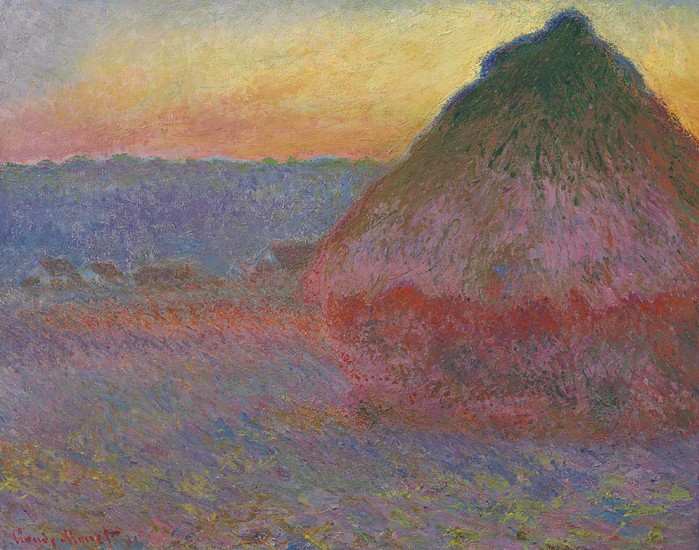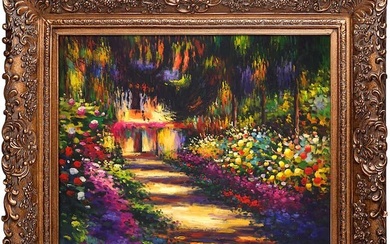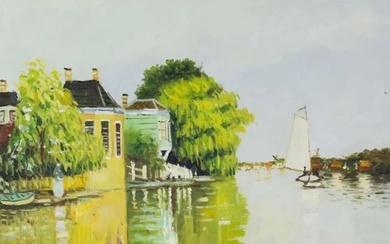Claude Monet (1840-1926), Meule
Claude Monet (1840-1926)
Meule
signed and dated 'Claude Monet 91' (lower left)
oil on canvas
28 5/8 x 36 ¼ in. (72.7 x 92.1 cm.)
Painted in 1891
Provenance
(possibly) M. Knoedler & Co. Inc., New York, (acquired from the artist, September 1891).
Mr. and Mrs. Potter Palmer, Chicago (1892).
Durand-Ruel Galleries, New York (acquired from the above, 28 June 1894).
Pierre Colle, Paris (acquired from the above, 3 April 1948).
Galerie Drouant-David, Paris.
Private collection (acquired from the above, 1948); sale, Hôtel des ventes, Bayeux, 4 June 1990, lot 64.
Private collection, Switzerland (acquired at the above sale); sale, Sotheby?s, New York, 11 May 1999, lot 116.
Acquired by the present owner, circa 2002.
View Special Publication: Claude Monet?s Meule
PROPERTY FROM AN IMPORTANT AMERICAN COLLECTION
It is difficult to imagine a more iconic Impressionist masterpiece than the work to be offered for sale on November 16, Monet's Meule, 1891, possibly the most vibrantly colorful of all the painter's slightly more than thirty variations on this motif that revolutionized modern art. Monet painted six of his grainstacks ("meule" in French) compositions already in 1888, and then fully realized his obsession with the subject starting in the autumn of 1890. This particular Meule is one of three canvases that are three inches taller than any of the others in format. Its pointed top rising to the upper edge of the canvas and its side cropped, the massive stack in the foreground is transcribed with short dashes of richly muted sunset colors, as is everything observed near and far, to the shadowy horizon of purplish hills visible in the distance across the Seine.
Monet's writer friend and fellow gardener Octave Mirbeau acclaimed Monet's new grainstack series in March 1891 as nothing less than "states of the planet's consciousness" and "the drama of the earth." Landscape as a theater for such cosmic forces was what Vincent van Gogh sought until his untimely death in the summer of 1890, only two or three months before Monet began to complete his grainstack series. Vincent's art dealer brother Theo bought two of the grainstack paintings and reserved a third already in January 1891. The pioneering abstract painter Wassily Kandinsky never forgot the revelation from seeing a grainstack painting at an exhibition in Moscow in 1896.
Monet's primary goal was to capture the flood of multi-colored daylight as visionary experience, but his painting represents a farmer's field with a typical round stack for the storage of harvested wheat to be thrashed. In Monet's increasingly urbanized world, such stacks had become postcard symbols of agricultural bounty as a blessing. Determined with his grainstack paintings to go beyond the brilliantly exacting transcription of visual sensations at the heart of Impressionist landscape painting, Monet explained the challenge to his art critic friend, Gustave Geffroy in October 1890: "... the further I go, the more I see that a lot of work is needed to get at what I am looking for: instantaneity, above all the envelope, the same light suffused everywhere. " Although the colors blend into an opalescent haze at a distance, up close Monet's Meule features hundreds of short staccato brushstrokes aligned as waves of colored light, layers of one color raking across previously applied layers to capture the pulse of light as a life force.
It was Monet's obsession to capture the scintillating play of light that prompted Paul Cézanne's comment: "Monet is only an eye. But what an eye!"
Monet habitually traveled as far afield as Brittany and the Mediterranean to find dramatic landscape subjects and fairytale light effects, especially after 1883 when he leased a large property in the Seine-side village of Giverny with room enough for his family of ten. He was successful enough to take a year off from painting starting in mid-1889 to run a fund-raising campaign for the purchase Eduouard Manet's Olympia as a donation to the French state. Did his devotion to his late friend's masterpiece provide Monet the incentive to return to his grainstacks and realize with them a new paradigm for contemporary art, as revolutionary as Olympia was thirty years earlier? Six weeks into his grainstacks campaign, Monet celebrated his fiftieth birthday on Nov. 14, 1890 and three days later he purchased his Giverny home. To the west his property bordered the farm field where he recorded his most subtle observations with countless touches of interwoven paint colors.
From seeing his grainstack paintings together in his studio, Monet realized how they enhanced one another and in December 1890 he pressed his dealer Paul Durand-Ruel for a solo exhibition. The May 1891 show, with fifteen grainstacks, sold out in days, according to Camille Pissarro, who at first complained that Monet was just repeating himself, but later in the year converted to series painting. In the preface to the May 1891 exhibition catalogue Geffroy compared the visual intensity of the grainstack paintings to gems, fire and blood. Indeed the idea to create and show groups of similar works together immediately became the norm for modern artists and galleries, and remains so today. It was thanks to this exhibition Monet became an international contemporary art star, as collectors competed to own not just one, but if possible several different examples. Most of all in demand were the paintings of sunsets. Having delivered five grainstacks to the agent for the New York dealer Knoedler in October 1891, Monet pointed out in particular one entitled "Derniers rayons du soleil": "I believe that I have succeeded well and it is not often that I say that about what I do." The exquisite Meule on offer is quite possibly the painting Monet described.
Charles Stuckey, Curator of Claude Monet, 1840-1926 presented at The Art Institute of Chicago in 1995.
PROPERTY FROM AN IMPORTANT AMERICAN COLLECTION
View it on
Sale price
Time, Location
Auction House
Claude Monet (1840-1926)
Meule
signed and dated 'Claude Monet 91' (lower left)
oil on canvas
28 5/8 x 36 ¼ in. (72.7 x 92.1 cm.)
Painted in 1891
Provenance
(possibly) M. Knoedler & Co. Inc., New York, (acquired from the artist, September 1891).
Mr. and Mrs. Potter Palmer, Chicago (1892).
Durand-Ruel Galleries, New York (acquired from the above, 28 June 1894).
Pierre Colle, Paris (acquired from the above, 3 April 1948).
Galerie Drouant-David, Paris.
Private collection (acquired from the above, 1948); sale, Hôtel des ventes, Bayeux, 4 June 1990, lot 64.
Private collection, Switzerland (acquired at the above sale); sale, Sotheby?s, New York, 11 May 1999, lot 116.
Acquired by the present owner, circa 2002.
View Special Publication: Claude Monet?s Meule
PROPERTY FROM AN IMPORTANT AMERICAN COLLECTION
It is difficult to imagine a more iconic Impressionist masterpiece than the work to be offered for sale on November 16, Monet's Meule, 1891, possibly the most vibrantly colorful of all the painter's slightly more than thirty variations on this motif that revolutionized modern art. Monet painted six of his grainstacks ("meule" in French) compositions already in 1888, and then fully realized his obsession with the subject starting in the autumn of 1890. This particular Meule is one of three canvases that are three inches taller than any of the others in format. Its pointed top rising to the upper edge of the canvas and its side cropped, the massive stack in the foreground is transcribed with short dashes of richly muted sunset colors, as is everything observed near and far, to the shadowy horizon of purplish hills visible in the distance across the Seine.
Monet's writer friend and fellow gardener Octave Mirbeau acclaimed Monet's new grainstack series in March 1891 as nothing less than "states of the planet's consciousness" and "the drama of the earth." Landscape as a theater for such cosmic forces was what Vincent van Gogh sought until his untimely death in the summer of 1890, only two or three months before Monet began to complete his grainstack series. Vincent's art dealer brother Theo bought two of the grainstack paintings and reserved a third already in January 1891. The pioneering abstract painter Wassily Kandinsky never forgot the revelation from seeing a grainstack painting at an exhibition in Moscow in 1896.
Monet's primary goal was to capture the flood of multi-colored daylight as visionary experience, but his painting represents a farmer's field with a typical round stack for the storage of harvested wheat to be thrashed. In Monet's increasingly urbanized world, such stacks had become postcard symbols of agricultural bounty as a blessing. Determined with his grainstack paintings to go beyond the brilliantly exacting transcription of visual sensations at the heart of Impressionist landscape painting, Monet explained the challenge to his art critic friend, Gustave Geffroy in October 1890: "... the further I go, the more I see that a lot of work is needed to get at what I am looking for: instantaneity, above all the envelope, the same light suffused everywhere. " Although the colors blend into an opalescent haze at a distance, up close Monet's Meule features hundreds of short staccato brushstrokes aligned as waves of colored light, layers of one color raking across previously applied layers to capture the pulse of light as a life force.
It was Monet's obsession to capture the scintillating play of light that prompted Paul Cézanne's comment: "Monet is only an eye. But what an eye!"
Monet habitually traveled as far afield as Brittany and the Mediterranean to find dramatic landscape subjects and fairytale light effects, especially after 1883 when he leased a large property in the Seine-side village of Giverny with room enough for his family of ten. He was successful enough to take a year off from painting starting in mid-1889 to run a fund-raising campaign for the purchase Eduouard Manet's Olympia as a donation to the French state. Did his devotion to his late friend's masterpiece provide Monet the incentive to return to his grainstacks and realize with them a new paradigm for contemporary art, as revolutionary as Olympia was thirty years earlier? Six weeks into his grainstacks campaign, Monet celebrated his fiftieth birthday on Nov. 14, 1890 and three days later he purchased his Giverny home. To the west his property bordered the farm field where he recorded his most subtle observations with countless touches of interwoven paint colors.
From seeing his grainstack paintings together in his studio, Monet realized how they enhanced one another and in December 1890 he pressed his dealer Paul Durand-Ruel for a solo exhibition. The May 1891 show, with fifteen grainstacks, sold out in days, according to Camille Pissarro, who at first complained that Monet was just repeating himself, but later in the year converted to series painting. In the preface to the May 1891 exhibition catalogue Geffroy compared the visual intensity of the grainstack paintings to gems, fire and blood. Indeed the idea to create and show groups of similar works together immediately became the norm for modern artists and galleries, and remains so today. It was thanks to this exhibition Monet became an international contemporary art star, as collectors competed to own not just one, but if possible several different examples. Most of all in demand were the paintings of sunsets. Having delivered five grainstacks to the agent for the New York dealer Knoedler in October 1891, Monet pointed out in particular one entitled "Derniers rayons du soleil": "I believe that I have succeeded well and it is not often that I say that about what I do." The exquisite Meule on offer is quite possibly the painting Monet described.
Charles Stuckey, Curator of Claude Monet, 1840-1926 presented at The Art Institute of Chicago in 1995.
PROPERTY FROM AN IMPORTANT AMERICAN COLLECTION







